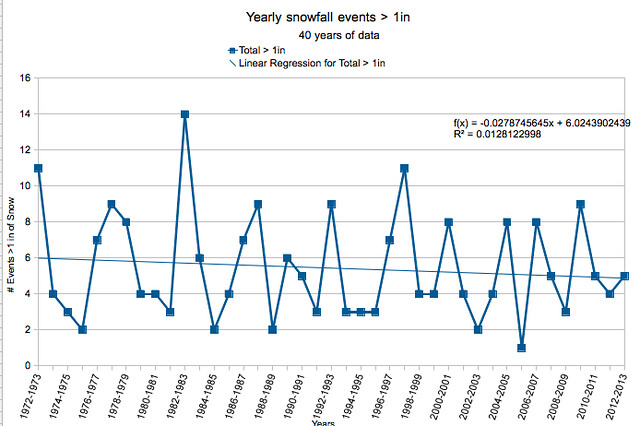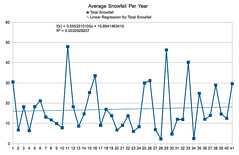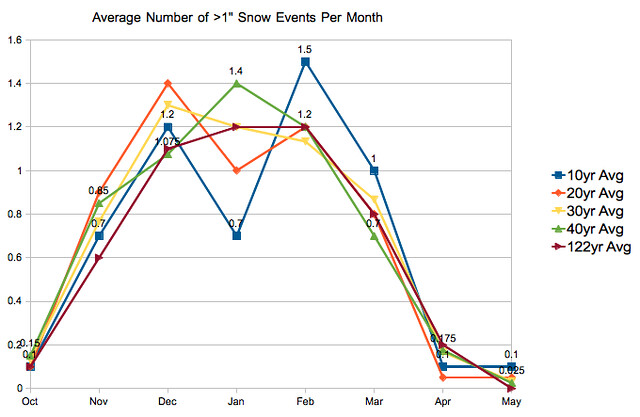Data & Analysis
As discussed previously, the change in the earth’s climate has been shown on a local level. The USA Today and the Washington Post recently discussed that the East Coast was enuring “Less Snow, More Blizzards” each winter. In Amarillo, it seems like that trend might also be true. The current average snowfall in Amarillo is .3″ higher than the 120-year average. And while that might not seem like much, it is on a trajectory to continue to grow.
Even though it is a minimal amount, does that mean Amarillo is also getting more snow and more blizzards?
Based on the data collected, the answer is no.
Examining the numbers from the past 40 years, the average number of snow events that drop more than 1″ of snow is declining and becoming more sporadic.

Notice that the trend line on the graph shows that 40 years ago, Amarillo averaged around six events of more than 1″ of snow. Now the average is below five. In fact, the past three winter seasons in Amarillo have lined up with the current trend.
Snow Events Greater Than 1″:
2010-2011 – 5
2011-2012 – 4
2012-2013 – 5
At the same time, the amount of snow Amarillo receives each winter has increased. And it continues to increase. As stated in the “Background” post the average snowfall in Amarillo “is 17.8 inches per year. But in the past 40 years that has shifted. Based on data extrapolation from the last 40 years, our current seasonal average of 18.1″ of snow.”
 Thinking critically, if more snow is falling on fewer events, the data is suggesting that Amarillo is getting more snow per snow event. This lines up with both the USA Today and Washington Post articles. Amarillo, like the East Coast, looks to be getting “less snow, more blizzards.”
Thinking critically, if more snow is falling on fewer events, the data is suggesting that Amarillo is getting more snow per snow event. This lines up with both the USA Today and Washington Post articles. Amarillo, like the East Coast, looks to be getting “less snow, more blizzards.”
Or in other words, there are a fewer number of regular snowfall and more extreme snowfall events.
To take it one step further, it turns out that 40 years ago Amarillo averaged just 2.8″ per snow event greater than 1″ snow event. Now Amarillo averages 3.5″ of snow per greater than 1″ snow event. It again shows that for each snow event greater than 1″, Amarillo is receiving more snowfall.

One could argue that the data might be skewed by recent snowfall. The Blizzard of ’13 in February of this year was a record setting event. It dropped more than 19″ of snow in 24 hours. Something like that would skew the data.
A counter-argument, though, is that any record snow event lines up with the suggestion within the data already. This is a trend. In fact, four of the 20 largest snow events in Amarillo history have hit in the past 12 years. One-quarter of all of the top 20 snow events have happened since 1986.
So if there are fewer snow events and more snow, does that mean winter is becoming shorter and more violent?
Based on the data, the answer is also, no.
 As it turns out, even though the number of events is going down, the length of the “snowy” season seems to be unchanged. Most of the greater than 1″ snow events happen in Amarillo between December and March.
As it turns out, even though the number of events is going down, the length of the “snowy” season seems to be unchanged. Most of the greater than 1″ snow events happen in Amarillo between December and March.
But there are two interesting trends in the data. The first is a slight increase in the number of snow events greater than 1″ during the past 40 years in October. The second is that January has become increasingly less snowy.
The data shows that during the past 40 years there have been six snow events of greater than 1″ in Amarillo. It had only happened 11 times prior – twice in 1971.
Conversely, if you take the average snow events during January over the past 120 years and compare it against the past 40, 30, 20 and 10 years, the pattern is quite prominent.

In the past 10 years, snow events of greater than 1″ are down nearly 50-percent from the 40 year average. On the opposite side of that coin, snow events in February have increased by 25-percent. In comparison, Amarillo has experienced more snowfall in December, February and March. And even equal amounts in November.

